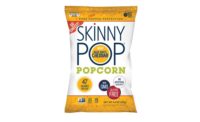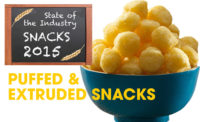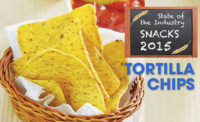Ready to Eat Popcorn thrives: State of the Industry 2015


courtesy of The Popcorn Factory

courtesy of American Pop Corn Co.

courtesy of Gaslamp Popcorn

courtesy of American Pop Corn Co.

courtesy of G.H. Cretors/Cornfields Inc.

courtesy of POP Gourmet Foods

courtesy of The Popcorn Factory












Popcorn may well be the oldest snack known to humankind, with numerous sources reporting the existence of ancient popcorn kernels in Mexican and South American caves thousands of years old. Like its early consumers, popcorn has evolved over the millennia. The puffy white clusters that have grown so popular are the result of decades of selective breeding, sporting decadent toppings or trendy flavors, and are ready-to-eat (RTE). They’ve migrated from fairs and movie theaters to upscale bars and restaurants to stores devoted entirely to—what else?—popcorn.
Overview | Chips | Puffed/Extruded Snacks | Popcorn | Snack Mixes & Nuts | Tortilla Chips | Pretzels | Frozen Snacks | Crackers
Market data
Despite Americans’ long history with, and love for, popcorn, the popcorn/popcorn oil category ranked last in overall dollar sales compared to our other snack categories: crackers, miscellaneous snacks (including trail mixes), snack nuts/seeds/corn nuts, salty snacks (including puffs, chips, pretzels, RTE popcorn, etc.) and frozen appetizers/snack roll—for the 52 weeks ending May 17, 2015, per IRI, Chicago. Popcorn reported $989.45 million for the period, down 2.44 percent in dollar sales.
The subcategory of RTE popcorn/caramel corn within salty snacks tells a very different story, taking in $1.01 billion, up 18.17 percent in dollar sales.
Within the popcorn/popcorn oil category, single-serve microwave popcorn recorded sales of $848.17 million in sales for the 52 weeks ending May 17, per IRI. This represents a 2.45 percent drop in dollar sales. Of the five leading single-serve microwave popcorn manufacturers, only Diamond Foods saw sales increase (1.44 percent).
Consumers might shy away from microwave popcorn today due to concerns about diacetyl, a natural, organic compound formerly used to lend a buttery flavor and aroma to microwave popcorn (manufacturers have phased out use of diacetyl for safety reasons related to plant production), and perfluorooctanoic acid (PFOA), a byproduct of the oil-repelling fluorotelomers sometimes used in the linings of microwave popcorn bags.
Convenience may be another factor. “Microwave’s dropping off because it’s not ready-to-eat,” says Alan Petrik, chief operating officer, The Popcorn Factory, Lake Forest, IL. “You can get popcorn tasting just as well out of the bag as popping it.”
Consumers’ frustration with wasted product may be another possible reason for microwave popcorn’s decline. “Microwavable popcorn is very similar to ready-to-eat popcorn,” says Meyer Futersak, founder and CEO, American Farmer Popcorn, Cedarhurst, NY. “The one major disadvantage of microwave popcorn is that you can’t visually see the popcorn kernels’ quality. Unfortunately, sometimes the performance of the popcorn is lower quality. Thus, you find more unpopped kernels in the bottom of the bag. With ready-to-eat popcorn, the unpopped kernels are removed from the manufacturing system and only popped flakes enter the bag.”
Kernel popcorn, also part of IRI’s popcorn/popcorn oil category, saw dollar sales decline 2.3 percent for the period, to $120.61 million. Four of the top five kernel popcorn vendors also saw sales drop from the same prior-year period, with only American Pop Corn Co., maker of JOLLY TIME Pop Corn seeing sales grow (up 3.10 percent).
In the strong RTE popcorn/caramel corn segment, multiple brands saw jumps in dollar sales, including Smartfood Delight, up 584.08 percent; Cape Cod, up 466.88 percent; Angie’s BOOMCHICKAPOP, up 129.75 percent; and Skinny Pop, up 101.11 percent.
Looking back
“Ready-to-eat popcorn has been on a phenomenal growth pattern,” says Petrik. “It was the snack of the year in 2013. That carried through to 2014, and it’s carrying it again in 2015.”
Garry Smith, president, American Pop Corn Co., Sioux City, IA, says: “Consumers are looking for snacks that are quick, yet healthy. In the past year, ready-to-eat has become extremely popular, with many new local and nontraditional popcorn brands now competing in the market.”
Part of popcorn’s popularity is its potential for healthy snacking. “With Americans becoming increasingly health-conscious, more consumers than ever are choosing healthier snack options,” says Claire Cretors, president, Cornfields Inc., Waukegan, IL. “The ready-to-eat popcorn category has benefited from this shift in attitudes and change in eating habits because popcorn is a familiar, natural and trusted healthy snack. It is popped (not fried), lower in fat and calories than many snacking options, naturally gluten-free, and typically made with non-GMO popcorn.”
The Cornfields brand G.H. Cretors uses only GMO-free ingredients and no artificial colors, flavors or preservatives, says Cretors, adding that Cornfields was the first certified-organic popcorn manufacturer. The company also maintains a partnership with the Whole Grains Council to ensure that its products deliver as much of the recommended whole grain daily intake as possible. According to IRI, G.H. Cretors RTE popcorn recorded sales of $8.75 million for the 52 weeks ending May 17, an increase of 4.01 percent.
Because it’s naturally gluten-free, popcorn has become a popular snack choice among people with gluten sensitivities. “Gluten-free seems to be a very important factor nowadays,” says Petrik, adding that The Popcorn Factory plans to offer all its products as gluten-free this fall.
“Gluten-free is an opportunity for sure,” says Mark Singleton, vice president of sales and marketing, Gaslamp Popcorn, Riverside, CA, suggesting that 15 to 20 percent of all new food items this year were gluten-free.
Like most other snack categories, popcorn has seen an explosion of new products made with better-for-you ingredients and sporting on-trend flavors.
The G.H. Cretors brand added Organic Popcorn this past year, in Extra Virgin Olive Oil and Simply Salted. The products use only USDA-certified organic and Non-GMO Project verified popping corn, 100 percent organic oils, and pure sea salt. The company added single-serve bags of the two flavors to the line in March. “The single-serve bags are the perfect on-the-go treat for health conscious snackers and flavor fanatics,” says Cretors.
Regional West Coast producer Gaslamp Popcorn makes its popcorn using non-GMO corn, pure cane sugar and locally produced olive oil, introduced two summer flavors in mid-April: Mango Habanero Salsa and Sweet Fiesta Lime. “Our Mango Habanero Salsa is just not a flavor that you’d considered two or three years ago,” says Singleton. “The explosion in the category has really given us an opportunity to cater to health-conscious consumers watching their calories and to also deliver some really flavorful items.”
In March, JOLLY TIME launched an RTE line with three flavors: White Cheddar, Kinda Sweet Kinda Salty and Sea Salted. The gluten-free products are made with non-GMO kernels, contain no trans fat and are endorsed by Weight Watchers. “We have also seen our audience respond well to unusual—yet delicious—flavors in the past, such as Jalapeño Butter and Mallow Magic, encouraging us to test new flavor combinations,” says Smith.
Petrik says The Popcorn Factory has “a bunch of things in the hopper.” He cites cherry popcorn with a dark chocolate coating, and pumpkin spice, cinnamon sugar and mesquite barbecue flavors as upcoming introductions. This past spring, the company launched a birthday cake flavor. “Popcorn can be spun into so many different flavors, profiles and combinations that it offers greater opportunities for the customer,” he says. “That’s why it’s continuing to grow.”
Popcorn producers need to find flavors that resonate with a wide range of consumers. “When you look at the data, you see all these flavors out there,” says David Israel, president and CEO, POP Gourmet Foods, Tukwila, WA, the 2015 Snack Food & Wholesale Bakery Snack Producer of the Year. “They might be great flavors, but they’re so unique—and I think the demographic for them is so small—how do you scale a business? If it’s a small company, with a couple of people, and that’s what you do, great. The market needs those companies. But for all those companies that pop up and offer a caramel popcorn or a cheese popcorn or a salt-and-pepper popcorn or whatever, I hate to say it, but they’re just cannibalizing each other. There’s only so much room.”
POP Gourmet has made a name for itself via unique flavors like Butter Toffee made with Almond Roca Buttercrunch, Rogue Blue Cheese and Huy Fong Sriracha, each resulting from co-branded partnerships. (Read more about POP Gourmet Foods in Snack Food & Wholesale Bakery’s February 2015 issue or online at www.snackandbakery.com.)
Looking forward
Not only is the popcorn category burgeoning with new products and brands, it’s also seeing an influx of new companies, which means more competition for existing manufacturers.
“It’s a very cluttered category,” says Israel. “Last year at the Sweets & Snacks Expo, a lot of popcorn companies popped up, and a lot of those guys didn’t return. This year, I saw a lot of larger companies—candy companies, bakery companies—that added popcorn to their lines, so there were a lot more new popcorn items this year. I think everybody sees popcorn as an easy to jump into product, and it is. I also see that most of them aren’t making their own product. They’re having it made or co-packed, so they might make a little adjustment here or there to the flavor profile, but they’re all doing about the same thing.”
Cretors says that as the popcorn category has grown, “many new players have entered the market with what we believe to be ‘average’ popcorn.” Given this growth, innovation must continue to keep consumers engaged. “Innovation helps keep the popcorn category fresh, with unique flavors, new sizes for new occasions and even limited-edition options,” she explains. “Without this innovation, consumers will become bored and shift their preferences to more-interesting categories to satisfy their better-for-you snacking desires.”
The competitive set continues to grow and change, says Petrik. “There are many competitors coming into the popcorn category today. There are those that have tenure and are hanging in there and continuing to innovate.” He notes that just like the chips side of the salty snack business, those companies have matured, and their core flavors are still out there, doing well and carrying their market share.
Despite this intense competition, the popcorn category will likely continue to offer innovative manufacturers plenty of opportunities for growth.
“We see the biggest opportunity in the ready-to-eat popcorn category, as that is where there is the highest demand right now from popcorn and snack consumers,” says Smith. “We also see an opportunity to bring more unique flavors to the market and are constantly testing new flavors and combinations. Another opportunity we see for the popcorn category is inclusion as an ingredient in classic snacks, such as nutrition bars, breakfast bars and trail mixes.”
Cretors cites nonretail markets as avenues for future growth. “The retail market—grocery, mass and club stores—has responded to growth in the popcorn category by increasing shelf space and offering more brands and varieties to consumers,” she explains. “There exists an opportunity for the foodservice, convenience and vending markets to respond similarly.”
Singleton, meanwhile, sees interaction with consumers as a way to continue to grow brands. “We have the opportunity to talk to our customers about great flavor ideas that they have,” he says.
Singleton adds that the immediate future for the popcorn category looks good. “It’s a simple food that everyone gets—everybody understands how it’s made,” he says. “Its simplicity is particularly on-message right now.”
Popcorn is simple and nutritious, says Futersak. “Compared to the many other snacks it competes with, popcorn will always be a great choice for consumers because of its simple ingredients,” he notes. “It’s also a great gluten-free snack that is easy for gluten-sensitive consumers to prepare and eat.” He adds that growth of new popcorn hybrids in the marketplace will continue to drive growth in this snack segment, and organic popcorn will continue to grow as supply catches up to demand.
Cretors says that as long as there is continued innovation in the category to maintain consumer interest, the outlook for this snack segment will be very positive. “While consumers are becoming increasingly health-conscious, they are also taking a very balanced approach to food and are allowing themselves to eat almost anything in moderation,” she says. “So while health is a key focus for most consumers, they are also giving themselves permission to indulge. Given this, I believe we can expect to see two key trends play out over the next several years: the continued launch of decadent offerings to satisfy consumers’ desire to treat themselves to delicious snacks, and the addition of functional and nutritional benefits to snacks—enhanced with protein, vitamins, etc.—as consumers seek options that will help them receive more benefits from their food, help keep them full between meals and even, for some, replace meals entirely.”
Petrik, says innovation will continue to drive RTE popcorn sales as companies and brands evolve. “We’ll continue to see innovation in flavors, packaging, packaging presentation, color, design—getting that emotional connection with the customer to get them to buy our product over the product sitting next to it on the shelf.”
The popcorn industry is solid, coming into its age at the right time, says Petrik, adding, “The key for us is to continue to evolve to keep pace with the changing consumer.”

Overview | Chips | Puffed/Extruded Snacks | Popcorn | Snack Mixes & Nuts | Tortilla Chips | Pretzels | Frozen Snacks | Crackers
Looking for a reprint of this article?
From high-res PDFs to custom plaques, order your copy today!
















